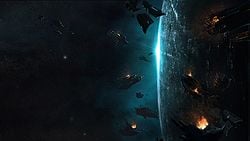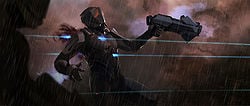Human-Forerunner wars
From Halopedia, the Halo wiki
- "Ten thousand years ago, humans had fought a war against Forerunners — and lost. The centers of human civilization had been dismantled and the humans themselves devolved and shattered into many forms, some said as punishment — but more likely because they were a naturally violent species."
- — Bornstellar Makes Eternal Lasting, circa 100,000 BCE
The Human-Forerunner War,[1] often referred to as the human-Forerunner wars,[2][3] is the collective term for a series of major interstellar conflicts fought between the human-San 'Shyuum alliance and the Forerunner ecumene for over a millennium from around 110,000 BCE to 109,000 BCE across the Orion Arm of the Milky Way galaxy. Waged concurrently with the Human-Flood war, the wars resulted in the dismantling of humanity's interstellar empire and in the quarantine of the San 'Shyuum species.[4] The Librarian considered this conflict to be the greatest threat to Forerunner power in their history and believed the conflict weakened the Forerunners enough to allow the Flood to emerge victorious until the firing of the Halos.[5]
History
Origins
Humanity held less power in the galaxy than the Forerunners, and so they held Forerunner interference with contempt. Looking to escape from the Forerunners' dominion, humanity expanded throughout the Orion Arm and eventually built an impressive empire consisting of at least 20,000 worlds in a thousand systems.[6] Humanity had allied themselves with the more technologically sophisticated San 'Shyuum; this alliance produced technology that easily rivaled that of the Forerunners. As they collected and reverse-engineered Precursor technology at Charum Hakkor, creating one of the largest collections of Precursor artifacts in the galaxy, humanity's rapid technological achievements made them increasingly arrogant and willing to challenge Forerunner dominance. This, coupled with their belief that they were the true inheritors of the Mantle from the Precursors rather than the Forerunners (which, ironically, turned out to be true), made them ideological enemies with the Forerunners. The Didact, commander-in-chief of the Forerunner military, saw humanity as one of the most contentious, bigoted, and self-centered species in the galaxy.[7]
Driven to desperation after losing many of their colonies in their conflict against the Flood, humanity invaded a Forerunner-controlled sector of space and annihilated fifty defenseless systems in which the Forerunners had resettled other species. After the indigenous populations were eliminated, humanity replaced them with human colonies to strengthen their hold over their new territories. Humanity looked to forcibly take new worlds anywhere, including those inhabited by Forerunners.[8] However, not all of this seemingly irrational violence was driven by the will to expand; instead, human fleets were sterilizing planets with Flood infestations.[9]
War
The rapid expansion of human technology and power elevated tensions with the more powerful Forerunner empire, culminating in a war of retaliation against the humans.[10]
Humanity had been forced to deploy the majority of their military against the Flood, sparing comparatively little to fight the Forerunners. By the time the Flood had been defeated, the human military was exhausted, and they did not have enough resources to put up a significant threat to the Forerunners. Although initially successful in destroying and conquering many Forerunner worlds and star systems, humanity was eventually pushed back to Charum Hakkor by Didact's Warrior-Servants.[8] Erda was one of the earliest worlds lost to the Forerunners, a tremendous blow to humanity's morale.[11] Over the course of the millennium-long conflict, humanity never came closer than 15,000 light years of the Orion complex, the center of Forerunner power.[12] The Didact managed to come up with a "star-hopping" plan, where Forerunner navies would jump to strategically important human worlds and simply skip other less important human star systems, allowing the Forerunners to conserve their resources and fight efficiently.[13]
Preceding the final conflict in the wars, humanity made great advances in military and science technology on par with those of the Forerunners, thanks to the efforts of humanity's Political and Morale Commander Yprin Yprikushma, who encouraged humans to study Forerunner technologies from humanity's earlier conflicts with Forerunners.[11] At the same time, the Forerunner Builder rate engineered numerous new weapons and vessels for the war effort, increasing their wealth and power by a tremendous degree.
Battle of Charum Hakkor
- Main article: Charum Hakkor campaign
Human forces continually lost star system after system. Eventually their capital at Charum Hakkor was cut off from the rest of the empire by the Didact's naval fleets. On Charum Hakkor, humanity incorporated Precursor technology into their own designs, constructing formidable fortifications capable of standing up to even the strongest fleets. Among them were unbending filaments that linked their orbital platforms' defenses. Despite having the combined Forerunner military at his disposal, it took great effort from the Didact to defeat the human resistance and capture the capital. Among the Forerunner casualties were all the Didact's children.[14]
Although cut off and unable to receive reinforcements from the San 'Shyuum, the humans held off continuous attacks for fifty years. The San 'Shyuum leadership surrendered to the Forerunners at some point during this time, leaving their human allies and the remaining San 'Shyuum on Charum Hakkor stranded. When the planet finally fell, a significant number of humans and San 'Shyuum committed suicide rather than being taken prisoner.[15]
Aftermath
Once humanity was defeated, the tragedies of the war convinced the Didact and his fellow Prometheans that using the Halo Array, like the destruction of humanity, would violate the Mantle. The Prometheans opposed and forestalled the construction of the Halo Array, succeeding in delaying the Array's activation for thousands of years.
The defeat was disastrous for both humanity and the San 'Shyuum. The victorious Forerunners decided to dismantle human civilization, causing the species to regress to a pre-technological state. In addition, they executed many humans for starting the conflict, seeing them as naturally violent and aggressive. Because of these steps, humanity's culture became splintered among their collective species, including the chamanush, the b'ashamanush, k'tamanush, and the hamanush.[16] Even ten thousand years later, many Forerunners considered this intraspecies fragmentation to be a form of punishment.[4]
Hoping to understand how humanity drove back the Flood, select humans had their memories extracted via the Composer. These memories were implanted by the Librarian in the genetic material of future human generations, designed to awaken when the right circumstances were met with the plan of utilizing them should the Flood return to challenge Forerunner power. This achievement spared humanity from extinction, a fate that had fallen on many species that challenged Forerunner control over the ages.[17] While humanity's defeat affirmed Forerunner dominance over the entire galaxy, the destruction of a major military power combined with the subsequent disbandment of the Forerunners' Warrior rate set the stage for the return of the Flood and the disastrous Forerunner-Flood war. The Forerunners were unprepared to deal with the Flood, as the humans had destroyed every piece of evidence about the parasite and the cure they had invented, possibly as a final act of vengeance. The Didact later regretted the devolution of humanity, as he had been unaware that the Flood was the reason for humanity's earlier aggression. The threat of the Flood would also lead to the rise of the Builder rate led by Master Builder Faber in Forerunner society over the Warrior-Servants and the banishment and execution of the Promethean leadership.[18]
The San 'Shyuum home system was placed under quarantine, with the Forerunner Fortress-class vessel Deep Reverence orbiting the species' homeworld, Janjur Qom. Access from outside of the system was blocked by a quarantine shield. When the Librarian attempted to index the San 'Shyuum during the early stages of Forerunner-Flood war, the San 'Shyuum mistook her intentions and rose in revolt against the Forerunners. Master Builder Faber took this opportunity to test Halo's effects on living beings, by testing the weapon on the San 'Shyuum homeworld. The test surpassed all expectations. This genocidal act led to the near extinction of the San 'Shyuum, as well as Faber's removal from power and his subsequent trial on charges of treason against the Mantle.
List of appearances
- Halo: Cryptum Template:First mentioned
- Halo: Primordium (Mentioned only)
- Halo 4
Sources
- ^ The Halo Bulletin - 6.20.12
- ^ Halo: Cryptum, pages 45, 47
- ^ Halo: Primordium, pages 236, 375
- ^ a b Halo: Cryptum, page 45
- ^ a b Halo 4, campaign level Reclaimer
- ^ Cite error: Invalid
<ref>tag; no text was provided for refs namedempire - ^ Halo: Cryptum, page 112-113
- ^ a b Halo: Cryptum, page 270-272
- ^ Halo 4, Terminals
- ^ Cite error: Invalid
<ref>tag; no text was provided for refs namedc130 - ^ a b Halo: Primordium, pages 237-238
- ^ Halo: Primordium, page 311
- ^ Halo: Primordium, page 187-188
- ^ Halo: Cryptum, page 138
- ^ Halo: Cryptum, page 118
- ^ Halo: Cryptum, page 127
- ^ Halo: Primordium, pages 234-235
- ^ Halo: Cryptum, pages 238-239

